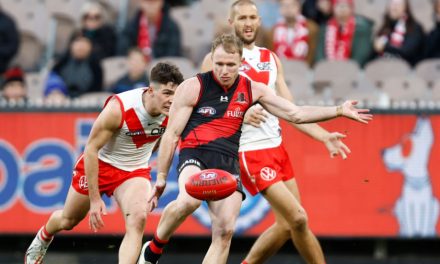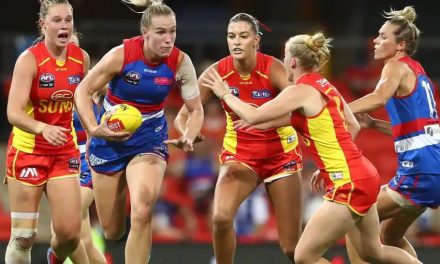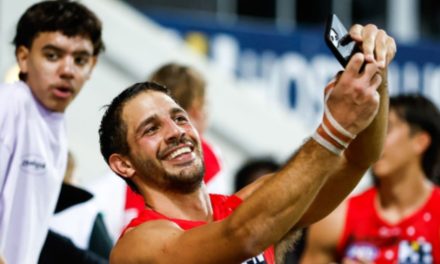James Hird won a Brownlow Medal, five All-Australian jumpers, five best-and-fairests and the 2000 Norm Smith Medal.
The 1990 AFL draft may well have produced the greatest steal in VFL/AFL draft history as a bloke by the name of James Hird slipped all the way down to pick No.79 and into the waiting arms of Essendon.
Hird would go on to become not only one of Essendon’s greatest ever players, but one of the best footballers to ever step on to a footy field.
So it goes without saying he replaces Geelong’s Stephen Hooper in No.1 spot in the revised top 10.
Hird was a magician. His footy IQ, his ability to consistently choose the right option, his skills, his class, his vision and his knack for rising to the big occasion and the big moments when his team needed him set him apart from the rest and also made him a truly great leader.
He kicked almost 350 goals in his career, but he was so versatile that, when called upon, he could be placed anywhere on the ground to fill a hole that needed filling.
Hird ended up playing 253 games for the Bombers in 17 seasons and in that time he won two premierships (once as captain), a Brownlow Medal, five All-Australian jumpers, five best-and-fairests and the 2000 Norm Smith Medal.
He captained the club for eight seasons, was inducted into the Australian Football Hall of Fame, named in the Essendon Team of the Century, ranked at No.3 in the “Champions Of Essendon” – behind only the great Dick Reynolds and John Coleman – and won the Anzac Day Medal on three occasions.
All that for pick 79? “Yes please,” Essendon said.
Of course, Hird’s time at Essendon wouldn’t be all peaches and cream. His coaching tenure was marred by the catastrophic supplements scandal which almost brought the club to its knees. But from a playing perspective, he was a true great of the game.
Coming in at No.2 behind Hird is the brilliant Allen Jakovich, who jumped up four places from six. He might have only played 54 games, but didn’t he leave his mark?
Jakovich burst on to the scene in 1991 for the Demons, becoming the fastest player in history to reach 50 goals – doing so in just nine games.
Not only was he capable of the downright freakish, as evidenced by his miraculous scissor-kick goal in the same game he snagged a career-best 11 majors against North Melbourne, but he defied his relatively small stature of 187cm to become a devastating focal point in attack for the Dees.
But almost as quickly as he arrived, Jakovich faded into obscurity. He finished up at Footscray and after 208 goals, at an average of four per game, Jakovich retired at the age of 28.
PLEASE HELP US CONTINUE TO THRIVE BY BECOMING AN OFFICIAL FOOTYOLOGY PATRON. JUST CLICK THIS LINK.
Star ruckman Matthew Clarke gets a nice boost from pick 56 to No.3.
Originally drafted by Richmond, Clarke didn’t play a game for the Tigers and had to wait until 1993 to finally make his senior debut with the Brisbane Bears.
He became a key figure in Brisbane’s transformation from perennial cellar dweller to contender during the 1990s, playing 130 games for them, including eight finals and two preliminary finals, and picking up a best-and-fairest along the way.
Clarke joined the Crows in 2000, in what would prove a fateful move. While he still enjoyed some success with them, playing in another 10 finals including three prelims, he departed Brisbane just before the Lions etched their name in history by winning a “three-peat” of flags and staking their claim as one of the greatest sides of all time.
Clarke finished his career with the Saints for a total of 258 games, but he finally tasted premiership success as a coach when he guided Adelaide’s women’s team to the 2019 and 20222 (Season 6) flags after suffering five losing preliminary finals as a player.
Swing man Jason McCartney stays put at No.4. Originally taken by Collingwood, he crossed to Adelaide after four years with the Magpies, before truly establishing himself as a bona fide defender with North Melbourne, where he played 107 of his 182 career games.
Tragically his career was cut short at the age of 29 as a result of significant injuries incurred in the 2002 Bali bombings, but he heroically made it back for one last game in 2003 before announcing his retirement on that same emotion-filled night against Richmond.
The new No.5 is big, gangly ruckman Matthew Burton, who was taken by West Coast with pick 36, but never actually played a game for the Eagles. He turned his awkward 210-centimetre frame into an asset, having a big impact for both Fremantle and North Melbourne.
Richmond goalsneak Nick Daffy enjoys a decent upgrade from pick 49 to No.6 thanks to an impressive 11-year career with the Tigers. Daffy was very clever around goals, ending up with a career-high bag of six majors and four hauls of five.
St Kilda and Melbourne defender Jamie Shanahan proved to be a huge bargain for the Saints, where he played most of his career. Originally taken at pick No.92, he went on to play 162 AFL games and shoots all the way up to No.7 in the revised top 10 as a result.
Enigmatic forward James “The Captain” Cook slides from pick two to eight. Cook ended up playing with three clubs and finished with 139 goals from 77 games. In his prime he was a very dangerous key forward, and was also capable of kicking a bag, with a haul of seven and five bags of six to his name.
The talented Fabian Francis and key defender Craig Ellis round out the top 10.
*Redrafts only consider the first time a player was drafted.












